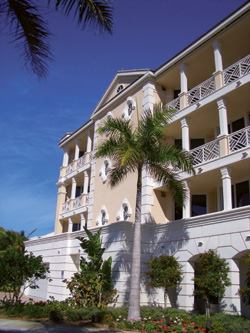Exterior Solutions Even without the single-family look and feel, design elements can be added to make a garden apartment more attractive. Replacing bottom units with attached garages is one solution, says Suer. “It’s a simple way of adding an appropriate feature.”
Waterton Associates adds unattached garages to rehab projects when the property has enough land and there is a reasonable payback period, says David Schwartz, managing member of the Chicago firm. “It’s an extra amenity that makes you more competitive” and should increase returns.
While “detached garages provide additional opportunities for ancillary income, attached garages provide a smoother transition from single-family home to apartment living, in addition to generating rent premiums,” says Dale Phillips, president of Phoenix-based Mark-Taylor Residential.
Before jumping into direct-access garages, developers must weigh some key considerations. “They have a huge impact on density, so usually they are used sparingly or in areas where you can get big rents to offset the loss of density,” says Matt Perrin, president of Phoenix-based Trillium Residential LLC, which uses direct-access garages in some projects. “Typically, they are used in the most upscale projects and are very popular with the renters who are willing to pay the money.”
Another trick to improve the exteriors of garden apartments is to break up the look by mixing in a three-story townhouse product, says Brit Perkins, principal at EDI Architecture Inc., based in Houston. Fellow architect Meeks agrees. Most “townhouses come with two-car garages and rear entry off the alley,” he says. “Townhouses provide a great rental product satisfying the need for two- and three-bedroom units. Plus, it’s a great convertible option to sell those units.”
Condo Concepts But today’s garden apartments have to do more than just attract renters: They have to appeal to buyers. “The trick with designing garden apartments is making them a lot more condo-convertible,” says Meeks. With vacancy rates at an all-time high, developers want options, and that means having a property that can be sold as condominiums without adding new interiors.
To accomplish that, garden apartment designers must remember the key spaces for home buyers and modify them accordingly. “It’s all about the kitchens and baths,” says Schwartz. In the kitchen, scrap the U-shaped kitchen with the bartop facing the dining room in favor of an L-shaped kitchen with the all-important island. “Residents will pay more for it, and it doesn’t cost much more to do,” says Humphreys, who adds that the one-time $100 cost of adding an island usually generates $25 more monthly in rent, should the apartment stay rental.
Condo readiness also requires higher-end finishes and appliances. Meeks says the semi-commercial look of stainless steel appliances and granite countertops is very popular, while Swedroe suggests higher-end projects might consider using cabinetry to mask the refrigerator and other appliances. Looking for just a touch of class, without too much cost? Add granite only to the kitchen island, Humphreys suggests.
Elsewhere in the unit, while renters are accustomed to smaller bathrooms, buyers want larger, nicer bathrooms. To make a project conversion-ready, bathrooms should feature double sinks and separate showers and tubs, says Meeks. Those willing to go the extra mile can seclude the water closet, Suer says.
But the most important consideration may be behind the walls. For a project to truly be condo-quality, soundproofing must be a priority. “Renters will accept [hearing their neighbors through the walls], but if you are buying, you don’t want to hear anybody,” Humphreys says. “We are starting to upgrade sound issues in all garden apartments.”
Plus, “the upgrades to interiors are actually driven more from a durability perspective, intended to reduce repair and replacement cost at turnover,” says Phillips.
